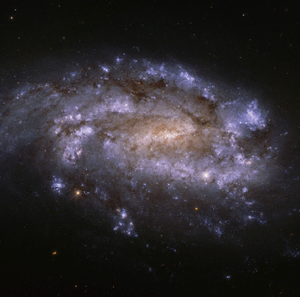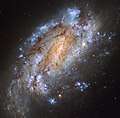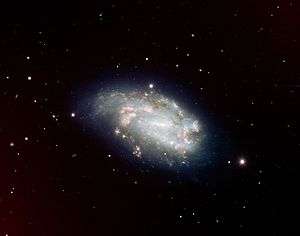NGC 1559
| NGC 1559 | |
|---|---|
 | |
| Observation data (J2000.0 epoch) | |
| Constellation | Reticulum |
| Right ascension | 4h 17m 35.8s[1] |
| Declination | −62° 47′ 1″[1] |
| Redshift | 1304 ± 4 km/s[1] |
| Apparent magnitude (V) | 11[1] |
| Characteristics | |
| Type | SB(s)cd[1] |
| Apparent size (V) | 3′.5 × 2′.0[1] |
| Other designations | |
| PGC 14814[1] | |
NGC 1559 is a barred spiral galaxy in the constellation Reticulum. It is also a Seyfert galaxy. Although it was originally thought to be a member of the Dorado Group,[2] subsequent observations have shown that it is in fact not a member of any galaxy group or cluster and does not have any nearby companions.[3][4] NGC 1559 has massive spiral arms and strong star formation.[3] It contains a small bar which is oriented nearly east-west and spans 40″.[3] Its bar and disc are the source of very strong radio emissions.[3]
In 2005, a Type 1a supernova, (SN 2005df) was observed. Two other supernovae discovered in NGC 1559 were SN 1984J and SN 1986L. All three were discovered by Australian amateur astronomer Robert Evans.[5]
Gallery
 NGC 1559 has massive spiral arms chock-full of star formation.[6]
NGC 1559 has massive spiral arms chock-full of star formation.[6] NGC 1559 obtained with the multi-mode FORS1 instrument on ESO's 8.2m VLT. Supernova SN 2005df is visible as the bright star just above the galaxy.
NGC 1559 obtained with the multi-mode FORS1 instrument on ESO's 8.2m VLT. Supernova SN 2005df is visible as the bright star just above the galaxy.
References
- 1 2 3 4 5 6 7 "NASA/IPAC Extragalactic Database", Results for NGC 4650A, retrieved 2007-04-03
- ↑ Huchra, J. P.; Geller, M. J. (June 15, 1982), "Groups of galaxies. I - Nearby groups", Astrophysical Journal, 257 (Part 1): 423&ndash, 437, Bibcode:1982ApJ...257..423H, doi:10.1086/160000
- 1 2 3 4 Beck, R.; Shoutenkov, V.; Ehle, M.; Harnett, J. I.; et al. (August 2002), "Magnetic fields in barred galaxies. I. The atlas", Astronomy and Astrophysics, 391 (1): 83&ndash, 102, arXiv:astro-ph/0207201, Bibcode:2002A&A...391...83B, doi:10.1051/0004-6361:20020642
- ↑ Maia, M. A. G.; da Costa, L. N.; Latham, David W. (April 1989), "A catalog of southern groups of galaxies", Astrophysical Journal Supplement Series, 69: 809&ndash, 829, Bibcode:1989ApJS...69..809M, doi:10.1086/191328, ISSN 0067-0049
- ↑ "Supernova Discoveries by Rev. Robert Evans". http://revivals.arkangles.com/. Archived from the original on 14 June 2014. Retrieved 11 July 2015. External link in
|website=(help) - ↑ "The loneliest firework display". www.spacetelescope.org. Retrieved 5 February 2018.
External links
- NGC 1559 on WikiSky: DSS2, SDSS, GALEX, IRAS, Hydrogen α, X-Ray, Astrophoto, Sky Map, Articles and images
Coordinates: ![]()